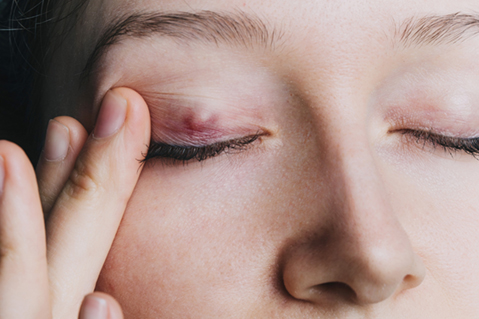
What are Styes and Chalazia?
Both styes and chalazia are visible bumps that appear near the edge of an eyelid. Many people get these two confused since they both can appear as a bump near the edge of the eyelid. It can actually be difficult to tell the two apart.
What is the Difference Between a Stye and a Chalazia?
The primary difference between a stye and a chalazia is the cause. A stye usually rises close to the edge of one of the eyelids and it is a red, sore bump. Styes can be caused by an eyelash follicle which has become inflamed. If a stye comes up under the eyelid or inside it then it is considered an internal hordeolum. A stye can also be caused if there is a backup of oil in a meibomian gland, which can lead to inflammation. This is a very small gland located inside the eyelid and its function is to provide oil for keeping the eye lubricated.
A chalazia is a Greek word which literally means “small lump.” This bump near the eyelid is caused when an oil producing gland becomes swollen and oil clogs up the opening. In contrast to a stye, this is typically a more slowly developing etiology. Moreover, usually a chalazia is located further from the eyelid’s edge than a stye is and it is usually larger. Finally, styes can be initially uncomfortable but chalazia typically are not.
Who Has an Increased Risk of Developing Styes or Chalazia?
Styes and chalazia are very common conditions and virtually anyone could develop either one. However, there are some people who have an increased chance of developing them. Those who have a condition called blepharitis which affects the margins of the eyelids are more likely to get either of these conditions. Other risk factors which increase the chances of developing one or the other include:
- Previous styes or chalazia
- Certain skin conditions like seborrheic dermatitis or acnea rosacea
- Presence of systemic conditions like diabetes
- Failing to completely remove eye makeup
- Using cosmetics that are old or contaminated
What are the Treatment Options Available?
Although it can be tempting, it is very important to never squeeze a stye or chalazion. Doing so can cause the inflammation to spread to nearby tissues in the eyelid. There are several treatment options available and depending on the specifics and severity of the condition one or more of these methods may be used:
- The mainstay of treatment involves warm compresses and lid scrubs. A warm compress may be applied to the affected eyelid to help unclog the gland so that it drains. Once the gland opens and the discharge is allowed to drain, then gentle massaging may help improve the condition by increasing the drainage until the backup is gone. Using lid scrubs can also help debulk any residual oil and improve the resolution of the bump.
- An antibiotic ointment may be prescribed to help as an adjuvant to warm compresses. This option may also be used for styes that recur or that do not improve following the use of warm compresses.
- If a chalazion becomes overly swollen a steroid injection may be used.
If all other treatments are ineffective, or if the vision is being affected, then it may be surgically removed.
